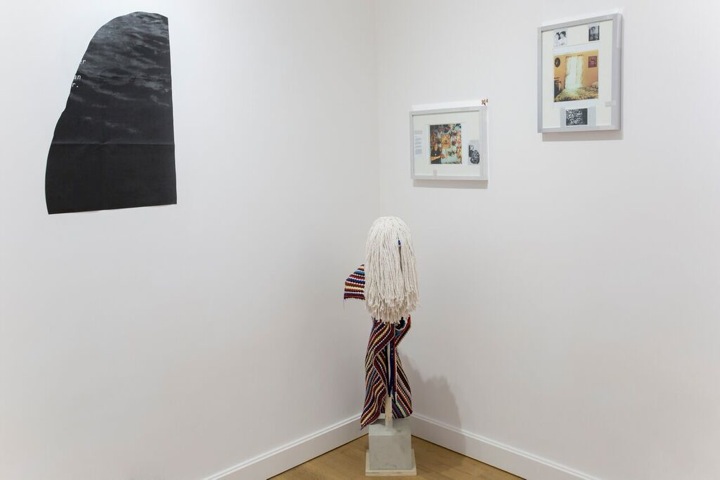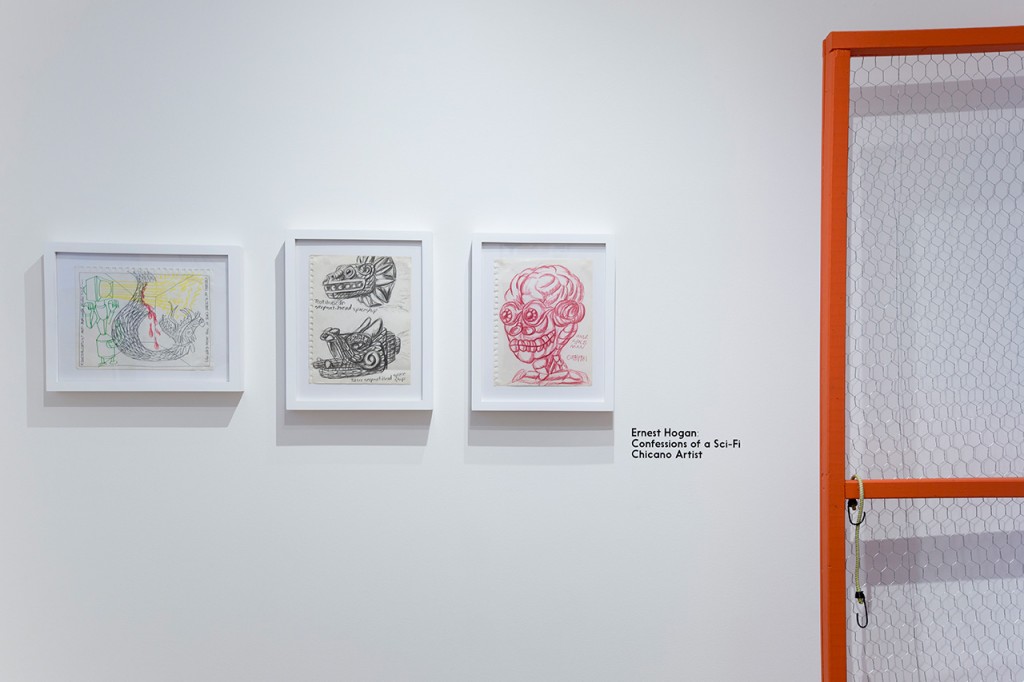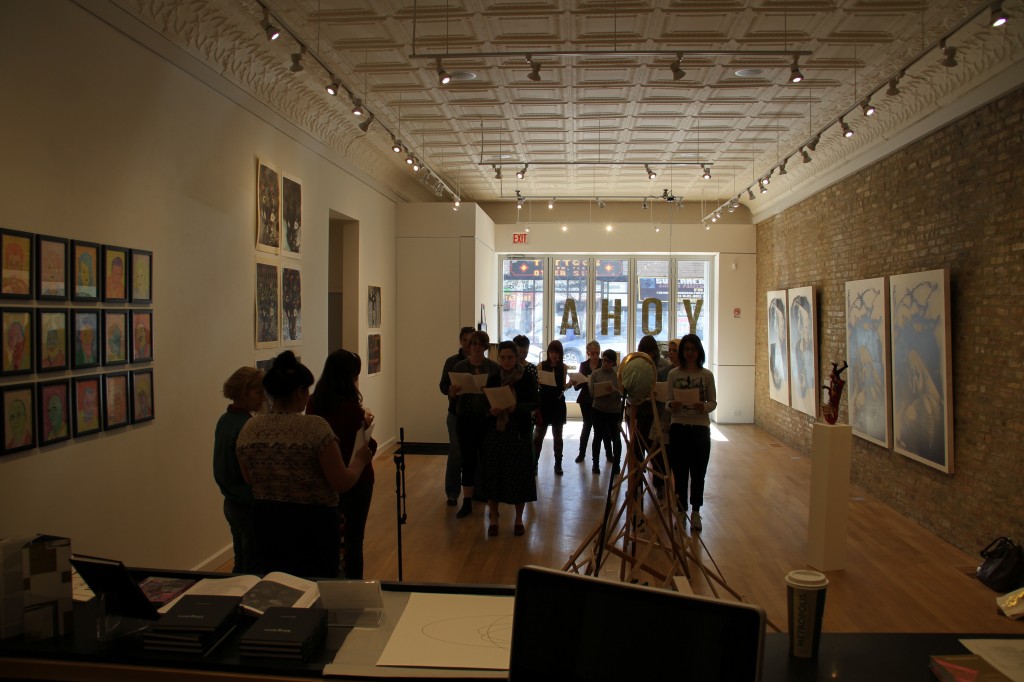
Sample Spread from Sonnenzimmer’s new book, Didactics (2015).
It seems like nonstop action in the Sonnenzimmer studio. Nick Butcher and Nadine Nakanishi are always working on something new. Most recently that includes an exhibition at the Center of Book and Paper Arts at Columbia College, a trip to Honolulu for its 87th annual print conference, and the release of their new book, Didactics, (jointly published by The Green Lantern Press and Sonnenzimmer). This coming Friday, March 27th, we’ll be celebrating the official release of that publication with a combined lecture/improvisatory music performance.
Caroline Picard: Didactics by Sonnenzimmer is a reprint of two previous artist-made books you all produced in house. Can you talk a little bit about those two components, how they functioned originally and what happens to the pair of them when you put them together?
Sonnenzimmer: Didactics combines “Warp and Weft: Poster Construction by Sonnenzimmer” (2012) and “Formal Additive Programs” (2010). Each of these projects served very different purposes originally, but in hindsight are connected. “Warp and Weft: Poster Construction by Sonnenzimmer” was structured as a documentation of our work with screen printed posters. Instead of a survey of all our poster work, we chose 30 of our favorite pieces and dissected them. We touch on the historical influence, project details and concepts, as well as included diagrams of their underlying compositions. For each poster we also included a small exercise as a window into our process. In that sense the book functioned almost like a text book for artists or designers who might be interested in our approach to graphic work. “Formal Additive Programs” on the other hand, was much more of an artist book, developed through the lens of 18 simple steps towards and abstraction. The idea to combine them stemmed from both books recently going out of print and their underlying “diagrammatic” and “instructional” tone.

Gallery view of Seripop’s (Yannick Desranleau and Chloe Lum) installation, at the Center for Book and Paper Arts, Columbia College Chicago, 2015
CP: Also—you all use a title font in the book that I understand you designed in house, as a studio font. What is that process like, and what made you want to design a font for yourselves?
SZ: On one hand the idea to produce an “exclusive” font to use for our self publishing projects was derived from our love for seriality within design. But there’s also a legacy of such practices more tied to art. Musician and artist Peter Brötzmann has used the same type treatment (a hand drawn version of Akzidenz Grotesk) on all of his music releases for decades. The visual punch his work brings collectively is fascinating. We were interested in exploring this. The font itself, called “Sonnenzimmer Manuscript” was initially developed for our 2015 exhibit, “Simultaneous: Seripop & Sonnenzimmer” curated by Julia V. Hendrickson, a “duo duo” show with Montreal artists Seripop (Yannick Desranleau and Chloe Lum). It was initially created specifically for the artist book, “The Impossibility of Language of Construction”, as the building block for the entire exhibition really. During the process, we decided to begin using it exclusively for our own publication projects.
CP: How did you arrive at this font specific design?
SZ: The typeface itself merges disparate influences, everything from hyper geometric faces like Paul Renner’s Futura, DIN, and Post Antiqua, a calligraphic script, to the more expressive and intuitive typography produced by Ed Fella. All in all we wanted something unique but legible.

Partial inner gallery view of Sonnenzimmer’s installation in “Simultaneous: Seripop & Sonnenzimmer” at the Center for Book and Paper Arts, Columbia College Chicago, 2015
CP: What was it like installing your show with Seripop and yourselves—to face an empty space, facing it with a parallel design/art studio, talking through your paired aesthetics?
SZ: We’ve been friends and fans of Seripop since the early 2000’s when we (Sonnenzimmer and Seripop) both began making screen printed posters. There aggressively graphic works were simultaneously intuitive and impactful combining bizarre illustration, pattern, and a keen sense for composition. They gradually moved away from a strictly graphic practice into installation environments that brought the graphic language they had developed into the third dimension. When we started to experiment with textiles in 2012, we had similar intentions, to bring our graphic language to a new medium. Though our aesthetic is notably different, our work tends to be much more pushed back and quiet, theirs a similar use of formal exploration and material experimentation that guides our processes. In the end they merge intuition with structure in some way. Developing the show in tandem, we both kept in mind that this would be a shared space, so I think the bodies of work both function individually and as an exhibit. We also were confronted in solving volume and loudness. How to exist next to work that is undeniable impactful, and still make a confident stance in respecting the environment but yields to stand in a different corner very “aloud”.
CP: I love the moment your paintings come off the wall and suddenly become wearable. How did that transition happen in your studio? Nadine describes them as enclosure paintings yet the mode of display seems very similar to kimonos that I’ve seen before. Is there a connection?
SZ: With “Simultaneous”, we wanted to create an environment, one conceptually connected to theater while respecting and questioning the legacy of gallery-oriented art. For us, making two of the works wearable invited direct participation by the viewer, but also made any viewer brave enough to wear one of the “enclosure paintings”, part of the artwork. The intention was that to fully appreciate the exhibit one would wear the “enclosure painting”, wear the headphones playing music produced by the two casted records spinning in the exhibit, and read through the manuscript, which acted as a poetic guide through the exhibit.

“Enclosure Painting 1” and “Enclosure Painting 2” 2015, Screen print and dye transfer on quilted canvas, 45 x 60 inches
CP: How did those records come about? Is there a difference, for instance, between the silent record-shapes that appear as objects in the show (I think of the record draped over a string overhead or the other record in a corner) and the playing records with blocks on them?
SZ: We look at it as exploring form in several fields at once (type, word, image, sound). What happens when these are combined. What is the experience? Perhaps its just too much to take in. Perhaps it creates its own fifth form. The records themselves are connected to Nick’s experimentation with the wood glue records he began producing in 2010 or so. Those were produced by pouring wood glue on top of found records, and peeling it off once it was dry. The glue would seep into the grooves of the records and make a fairly accurate “copy” (though inverted) of the original music when peeled off and played, with the added bonus of being backwards and having lots of surface noise. This led to later experimentation with producing silicon molds of original recordings and producing one-off records using a liquid plastic product for casting. The addition of the sculptural shaped elements was just and extension of the possibilities the molding process allowed. Here, laser cut shapes were attached to the master record, and then mold was made. The resulting records have protruding shapes that work as looping devices as they deny the tone arm from proceeding and actually slap it back a few inches in the process, creating a sort of chance operation within the loop produced. Because of the qualities of the liquid plastic used for casting, acrylic paint added to the silicon mold, becomes permanently affixed to the casted recorded, totally integrated and imbedded into the surface. The formal connections between the shapes on the records and those in the artist book, as well as the “enclosure paintings” and the hanging record are intentional.

One of “Flums”, by Sonnenzimmer, 2015, Cast record on string, 12 x 6 inches
CP: You traveled to Hawaii for the Honolulu Print Makers 87th annual Exhibition. This is something you juried, I believe. How was it to go through 230 submissions?
SZ: Picking work from 230 submissions would have been impossible, so our first step was to eliminate 100 pieces immediately. This was done totally viscerally and intuitively. From there, we eliminated pieces that seemed redundant. The process of jurying was actually quite easy, mostly because the quality of work was so exceptionally high. As it turns out Honolulu has what we think is the strongest printmaking community in the country.
CP: What was it like to be invited for to participate there?
SZ: Being invited to jury the 87th Annual Honolulu Printmakers Exhibition has been a huge honor and definitely a milestone for us. The group, while receiving some institutional support (they have pro-rated rent at the Honolulu Museum of Art School), is totally member run. Duncan Dempster, the executive director, is in his second year in the job and is doing an amazing job and maintaining its legacy while bringing printmaking to a new generation. Print in Hawai’i has a special status, maybe due to its proximity to Asia and the huge asian influence, but also its indigenous populations tradition of craft and the European influence that arrived in the 1930s. The work produced there seamlessly amalgamates and transcends these influences and is uniquely its own. Our studio is hybridization in its own right, so we felt very in tune with that spirit there.
Come celebrate the release of Sonnenzimmer’s latest publication, Didactics, at Sector 2337 this coming Friday, March 27th. For that event, Jack Henrie Fisher will present a draft of a slide show titled “The book as value form: 10 contradictions,” enumerating a set of cases in which the book-as-commodity produces and reflects formal ruptures in the political economy. Fisher’s talk is followed by an improvisational musical featuring Keefe Jackson (tenor sax), Jason Roebke (double bass), and Jordan Martins (pedal steel, guitar). That group will use the 18 steps of Formal Additive Programs that Sonnenzimmer printed in Didactics (basically a set of poetic instructions towards abstraction) via an improvised performance.








































